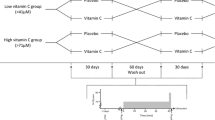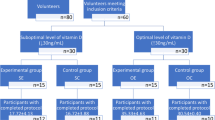Abstract
The aim of this study was to investigate whether post-exercise vitamin C supplementation influences recovery from an unaccustomed bout of exercise. Sixteen male subjects were allocated to either a placebo (P; n=8) or vitamin C (VC) group (n=8). Subjects performed a prolonged (90-min) intermittent shuttle-running test, and supplementation began after the cessation of exercise. Immediately after exercise the VC group consumed 200 mg of VC dissolved in a 500 ml drink, whereas the subjects in the P group consumed the drink alone. Later on the same day and then in the morning and evening of the following 2 days, subjects consumed additional identical drinks. Plasma VC concentrations in the VC group increased above those in the P group 1 h after exercise and remained above P values for the 3 days after exercise. Nevertheless, post-exercise VC supplementation was not associated with improved recovery. Post-exercise serum creatine kinase activities and myoglobin concentrations were unaffected by supplementation. Muscle soreness and the recovery of muscle function in the leg flexors and extensors were not different in VC and P groups. Furthermore, although plasma concentrations of interleukin-6 and malondialdehyde increased following exercise, there was no difference between VC and P groups. These results suggest that either free radicals are not involved in delaying the recovery process following a bout of unaccustomed exercise, or that the consumption of VC wholly after exercise is unable to deliver this antioxidant to the appropriate sites with sufficient expediency to improve recovery.




Similar content being viewed by others
References
Anderson R, Lukey P (1987) A biological role for ascorbate in the selective neutralisation of extracellular phagocyte-derived oxidants. Ann N Y Acad Sci 498:229–247
Armstrong R, Warren G, Warren J (1991) Mechanisms of exercise-induced muscle fibre injury. Sports Med 12:184–207
Benzie I, Strain J (1997) Acute post-ingestion changes in plasma ascorbic acid concentration: Relationship to dose and existing body stores. Nutr Res 17:187–190
Best T, Fiebig R, Corr D, Brickson S, Ji L (1999) Free radical activity, antioxidant enzyme, and glutathione changes with muscle stretch injury in rabbits. J Appl Physiol 87:74–82
Borg G (1973) Perceived exertion: a note on ''history'' and methods. Med Sci Sports Exerc 5:90–93
Bushell A, Klenerman L, Davies H, Grierson I, Jackson M (1996) Ischaemia-reperfusion-induced muscle damage. Acta Orthop Scand 67:393–398
Clarkson P, Sayers S (1999) Etiology of exercise-induced muscle damage. Can J Appl Physiol 24:234–248
Demopoulos H (1973) Control of free radicals in biologic systems. Fed Proc 32:1903–1908
Duarte J, Appell H, Carvalho F, Bastos M, Soares, J (1993) Endothelium-derived oxidative stress may contribute to exercise-induced muscle damage. Int J Sports Med 14:440–443
Fukunaga K, Suzuki T, Takama K (1993) Highly sensitive high-performance liquid chromatography for the measurement of malondialdehyde in biological samples. J Chromatogr B Anal Technol Biomed Life Sci 621:77–81
Gleeson M, Robertson J, Maughan R (1987) Influence of exercise on ascorbic acid status in man. Clin Sci 73:501–505
Hasson S, Daniels J, Divine J, Niebuhr B, Richmond S, Stein P, Williams J (1993) Effect of ibuprofen use on muscle soreness, damage, and performance: a preliminary investigation. Med Sci Sports Exerc 25:9–17
Jakeman P, Maxwell S (1993) Effect of antioxidant vitamin supplementation on muscle function after eccentric exercise. Eur J Appl Physiol 67:426–430
Jenkins R, Krause K, Schofield L (1993) Influence of exercise on clearance of oxidant stress products and loosely bound iron. Med Sci Sports Exerc 25:213–217
Kaminski M, Boal R (1992) An effect of ascorbic acid on delayed-onset muscle soreness. Pain 50:317–321
Klocke F, Copley D, Krawczyk J, Reichlin M (1982) Rapid renal clearance of immunoreactive canine plasma myoglobin. Circulation 65:1522–1528
Koller A, Mair J, Schobersberger W, Wohlfarter T, Haid C, Mayr M, Villiger B, Frey W, Puschendorf B (1998) Effects of prolonged strenuous endurance exercise on plasma myosin heavy chain fragments and other muscular proteins. J Sports Med Phys Fitness 38:10–17
Kong Y, Lesnefsky E, Ye J, Horwitz L (1994) Prevention of lipid peroxidation does not prevent oxidant-induced myocardial contractile dysfunction. Am J Physiol 267:H2371–H2377
Kuipers H, Drukker J, Frederik PM, Geurten P, Kranenburg G (1983) Muscle degeneration after exercise in rats. Int J Sports Med 4:45–51
Levine M, Conry-Cantilena C, Wang Y, Welch R, Washko P, Dhariwal K, Park J, Lazarev A, Graumlich J, King J, et al (1996) Vitamin C pharmacokinetics in healthy volunteers: evidence for a recommended dietary allowance. Proc Natl Acad Sci U S A 93:3704–3709
MacIntyre D, Reid W, Lyster D, Szasz I, McKenzie D (1996). Presence of WBC, decreased strength, and delayed soreness in muscle after eccentric exercise. J Appl Physiol 80:1006–1013
Neumeier D, Prellwitz W, Knedel M (1981) Creatine kinase isoenzymes after myocardial infarction. In: Lang H (ed) Creatine kinase isoenzymes. Springer, Berlin Heidelberg New York, pp132–154
Newham D, McPhail G, Mills K, Edwards R (1983) Ultrastructural changes after concentric and eccentric contractions of human muscle. J Neurol Sci 61:109–122
Pedersen B, Ostrowski K, Rohde T, Bruunsgaard H (1998) The cytokine response to strenuous exercise. Can J Physiol Pharmacol 76:505–511
Radak Z, Asano K, Inoue M, Kizaki T, Oh-ishi S, Suzuki K, Taniguchi N, Ohno H (1995) Superoxide dismutase derivative reduces oxidative damage in skeletal muscle of rats during exhaustive exercise. J Appl Physiol 79:129–135
Rokitski L, Logemann E, Sagredos A, Murphy M, Wetzel-Roth W, Keul J (1994) Lipid peroxidation and antioxidant vitamins under extreme endurance stress. Acta Physiol Scand 151:149–158
Shukla S (1969) Plasma and urinary ascorbic acid levels in the post-operative period. Experientia 25:704
Smith L (1991) Acute inflammation: the underlying mechanism in delayed onset muscle soreness? Med Sci Sports Exerc 23:542–551
Sorichter S, Mair J, Koller A, Gebert W, Rama D, Calzolari C, Artner-Dworzak E, Puschendorf B (1997) Skeletal troponin I as a marker of exercise-induced muscle damage. J Appl Physiol 83:1076–1082
Thomas JR, Salazar W, Landers DM (1991) What is missing in p<0.05? Effect Size. Res Q Exerc Sport 62:344–348
Thompson D, Nicholas CW, Williams C (1999) Muscle soreness following prolonged intermittent high-intensity shuttle running. J Sports Sci 17:1-9
Thompson D, Williams C, Kingsley M, Nicholas CW, Lakomy HKA, McArdle F, Jackson MJ (2001a). Muscle soreness and damage parameters after prolonged intermittent shuttle-running following acute vitamin C supplementation. Int J Sports Med 22:68–75
Thompson D, Williams C, McGregor S, Nicholas CW, McArdle F, Jackson MJ, Powell J (2001b) Prolonged vitamin C supplementation and recovery from demanding exercise. Int J Sports Nutr Exerc Metab 11:468–484
Tidball J (1995) Inflammatory cell response to acute muscle injury. Med Sci Sports Exerc 27:1022–1032
Van Der Meulen J, McArdle A, Jackson M, Faulkner J (1997) Contraction-induced injury to the extensor digitorum longus muscles of rats: the role of vitamin E. J Appl Physiol 83:817–823
Warren G, Lowe D, Armstrong R (1999) Measurement tools used in the study of eccentric contraction-induced injury. Sports Med 27:43–59
Weiss S (1989) Tissue destruction by neutrophils. N Engl J Med 320:365–376
Zerba E, Komorowski T, Faulkner J (1990) Free radical injury to skeletal muscles of young, adult and old mice. Am J Physiol 258:C429–C435
Acknowledgements
The authors would like to acknowledge the financial support of SmithKline Beecham, UK. The work described in this paper complies with the current laws of the UK.
Author information
Authors and Affiliations
Corresponding author
Rights and permissions
About this article
Cite this article
Thompson, D., Williams, C., Garcia-Roves, P. et al. Post-exercise vitamin C supplementation and recovery from demanding exercise. Eur J Appl Physiol 89, 393–400 (2003). https://doi.org/10.1007/s00421-003-0816-4
Accepted:
Published:
Issue Date:
DOI: https://doi.org/10.1007/s00421-003-0816-4




